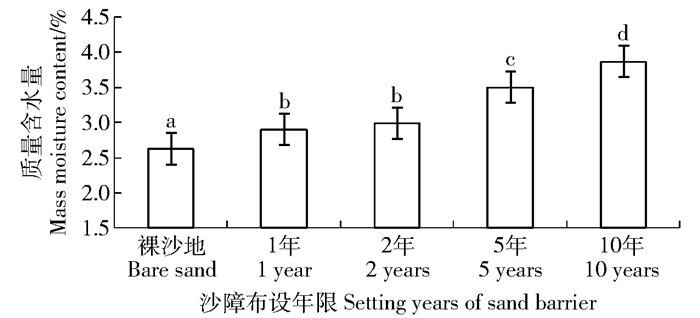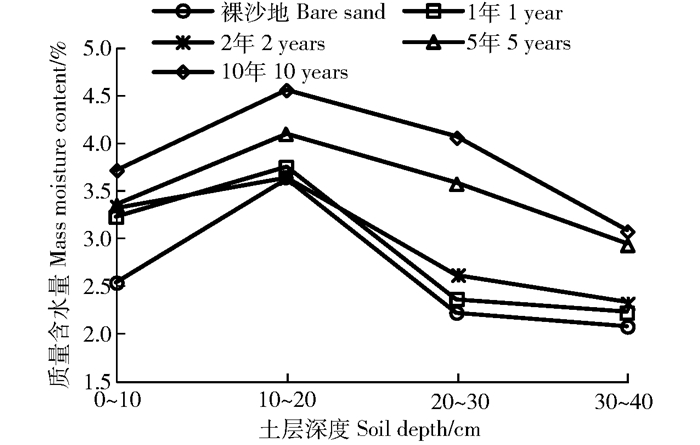2. 北京林业大学水土保持学院宁夏盐池毛乌素沙地生态系统国家定位观测研究站, 100083, 北京;
3. 中国林业科学研究院荒漠化研究所, 100091, 北京
中国水土保持科学  2018, Vol. 16 2018, Vol. 16  Issue (5): 10-15. DOI: 10.16843/j.sswc.2018.05.002 Issue (5): 10-15. DOI: 10.16843/j.sswc.2018.05.002 |
我国是世界上荒漠化最严重的国家之一,机械沙障作为工程治沙的主要方法之一,在荒漠化防治工作中得到广泛应用[1-3]。受水源及气候条件限制,生物措施往往无法实行,强制应用植物治沙反而会导致水资源匮乏、生态退化[4-5]; 因此机械沙障被视为生物治沙的前提和保障[6]。机械沙障利用不同的材料,在沙面上设置成各种形式的障碍物,增加地表粗糙度,进而控制风沙流运动方向、速度、结构等,起到防风固沙的作用[7-9]。
沙障可以改变下垫面性质,改善局部小气候,重塑地表微地形,改良地表微环境,为先锋植物的生存提供良好的环境,进而促进耐干旱灌木的生长[10-12]。植物自身涵养水源、保持水土的功能以及腐殖质的消化分解又起到改良土壤的作用,促进生态的恢复[13-14]。在一系列的工程措施中,草方格是应用时间最长,效果较好的材料之一[15]。笔者选取设置1、2、5、10年的草方格沙障样地进行取样分析,并与裸沙地进行对比,观察不同年限的沙障对沙地土壤改良的作用。
1 研究区概况研究区位于宁夏盐池毛乌素沙地生态系统国家定位观测研究站(E 106°30'~107°41', N 37°04'~38°10'),海拔在1 350~1 500 m之间,地处毛乌素沙地南缘核心区,属缓坡丘陵地貌。气候属中温带大陆性季风气候,常年干旱少雨,年均降水量275 mm,其中7—9月降水量占全年降水量的65%以上,潜在蒸发散为降水量的5~7倍,年平均气温为7.8 ℃,年日照时间约为2 867.3 h,无霜期124 d左右,年大风期24.2 d,年沙尘暴期20.6 d,年平均风速为2.8 m/s。研究区植被区系属欧亚草原带,受水分条件限制,植物种属较少,群落结构简单,植被类型以沙生草本和灌木为主[16],沙生草本主要分布在基质疏松的流动沙丘,以沙米(Agriophyllum squarrosum)、虫实(Corispermum hyssopifolium)为主,灌木优势种为油蒿(Artemisia ordosica)、柠条(Caragana Korshinskii)等。
2 研究方法 2.1 采样点选择气象和植被状况会对沙地土壤的含水量及粒径产生影响,强风吹蚀沙地表面干沙层,致使表层沙土粒径粗化,并且导致湿沙层上移;降雨会增加土壤含水量,促进沙地先锋植物萌发:因此本实验选在生长季前,且前1周无大风、降雨天气的时间进行取样。为消除地形因素对试验的影响,笔者选择布设有1 m×1 m麦草方格的平坦沙地作为研究对象,分别在沙障布设1、2、5、10年的样地进行取样,每个样地随机选取5个取样点,用土钻分别在0~10、10~20、20~30和30~40 cm土层获取土样;同时在每个样地随机布设3个2 m×2 m的样方,调查植被种类及群落结构,分析不同年限的沙障对生态恢复的影响。
2.2 测定方法在采样点获取土样时,将一部分土样装入铝盒内密封,标注样点信息,用于土壤含水量的测定,一部分装入自封袋中,标注样点信息,用于土壤粒径的测定。土壤粒径的分级采用美国制土壤机械组成划分标准;土壤含水量的测定采用烘干法,在采样点将新鲜土样装入铝盒后称量烘干,计算质量含水量;土壤粒径的测定是利用激光粒度分析仪Microtrac S 3500进行的,植被群落调查采用样方法,并利用Photoshop像素点数法计算其盖度。
3 结果与分析 3.1 不同年限的草方格对土壤含水量的影响 3.1.1 对土壤整体含水量的影响对比分析不同年限的草方格沙障对土壤整体含水量的影响,如图 1所示:随着沙障布设年限的增加,土壤整体含水量表现出上升的趋势,布设年限和土壤含水量之间呈正相关关系。沙障布设1年后土壤质量含水量显著增长,但第2年增长不显著,沙障布设前2年的含水量分别为裸沙地的1.11和1.14倍。布设年限5年时土壤含水量增长较为明显,为裸沙地的1.36倍,布设年限10年时土壤含水量为裸沙地的1.47倍。

|
图 1 不同年限的沙障对土壤整体质量含水量影响的比较(P<0.05) Fig. 1 Effect comparison of sand barrier in different setting years on mass moisture content (P < 0.05) |
对比分析不同年限的草方格沙障对不同土壤层含水量的影响,由图 2可见:不同土层的土壤含水量与沙障布设年限之间均呈正相关关系。0~10 cm的土层中,草方格沙障布设1、2、和5年的土壤含水量差异较小,但都明显高于裸沙地,分别是裸沙地的1.27、1.31、1.32倍,沙障布设10年的土壤含水量是裸沙地的1.46倍。10~20 cm的土层中,裸沙地、1年、2年的土壤含水量差异较小,5年的土壤含水量涨幅较大,是裸沙地的1.13倍,10年的含水量明显高于5年的土壤含水量,为裸沙地的1.26倍。20~30 cm的土层中,裸沙地、1和2年的土壤含水量增长缓慢,5年的土壤含水量增幅较大,是裸沙地的1.61倍,10年的土壤含水量高于其他年限值,为裸沙地的1.81倍。30~40 cm的土层中,裸沙地、1和2年的土壤含水量差距较小,5和10年的土壤含水量相对一致,分别为裸沙地的1.41和1.48倍。

|
图 2 不同年限的沙障对不同土壤层质量含水量的影响比较(Tukey HSD,P<0.05) Fig. 2 Comparison of the effects of sand barriers in different years on the mass moisture content at different soil layers |
0~10 cm的土层中,沙障布设1年后含水量即出现明显上升,1~5年间含水量维持在稳定状态,5~10年间含水量小幅上涨,10年共计涨幅为1.18%。10~20 cm的土层含水量为各土层的最高,但整体涨幅为各土层最低,沙障布设后2年内含水量变化较小,2~10年出现明显上升,10年共计涨幅为0.94%。20~30 cm的土层中,0~5年间含水量增长幅度较大,为5~10年的2.8倍,10年共计涨幅为1.85%。30~40 cm的土层中,含水量在沙障布设5年后达到较为稳定的状态,5~10年涨幅较小,10年共计涨幅为1%。不同土层的含水量在沙障布设后的前5年增长幅度均>5~10年期间。
3.2 不同年限的沙障对土壤粒径的影响对比分析不同布设年限的草方格沙障样地的土壤粒径,如表 1所示:对于同一样地,不同深度的土壤的黏粒、粉粒、砂粒占比相对稳定,砂粒占绝大多数,粉粒含量较低,黏粒含量极少。随着沙障布设时间的增长,各层次的土壤均呈现出黏粒、粉粒含量上升,砂粒含量下降的趋势。
| 表 1 不同年限的沙障样地的土壤粒径 Tab. 1 Soil particle size of sand barrier sample plot in different years |
不同土层的土壤机械组成在沙障布设后2年内的变化幅度最大,黏粒、粉粒含量上升明显,砂粒含量下降幅度较大,在2~5年之间土壤改良趋势不变,但是变化幅度较小,主要是粉粒含量的少量增加,在5~10年黏粒含量相对一致,粉粒含量小幅提高,相应的砂粒含量有所下降。0~10年黏粒含量平均上涨2.5倍,粉粒含量平均上涨1.98倍,砂粒含量平均降低5.25%。其中,表层沙土黏粒、粉粒含量增长较快,土层越深,黏粒和粉粒增长越慢,这是由于土壤的改良主要是由植被枯枝落叶及腐殖质进行的,枯枝落叶很难进入土壤深层,因此表层沙土结构变化较为迅速。
3.3 不同年限的沙障对植被恢复的影响分析不同年限的沙障样地植被恢复状况,由表 2可知:沙障布设1年后即出现少量先锋植物沙米,盖度较小,集中分布在沙障网格内靠近边缘的位置,沙障布设2年后出现草本植物虫实,同时沙米的植株增多,盖度增大,主要分布在网格前半部分靠近边缘的位置,沙障布设5年后出现当地优势种灌木油蒿,且虫实的数量急剧增长,形成稳定的群落结构,同时沙米群落消退,此时草本植物盖度占比为68.2%,沙障布设10年后先锋植物消失,形成油蒿群落。
| 表 2 不同年限的沙障样地植被恢复状况 Tab. 2 Vegetation restoration in sand barrier sample plot in different years |
沙障的生态恢复功能是通过防风固沙以改善局地微气候,为植被的生长创造良好条件,从而利用植被的演替来实现的。同土壤质量含水量的数据结合来看,草方格沙障布设1年后即出现先锋植物,此时土壤表层含水量明显上升,深层变化较小,说明先锋草本植物具备一定的涵养水源的作用,由于其根系较浅,因此仅对表层土壤有影响;5年后先锋草本植物形成稳定植物群落,且出现灌木植株,在此过程中,土壤深层含水量增加明显,这是由于灌木根系较为发达,根蘖深入到土壤深层;10年完成先锋草本植物稳定群落向灌木稳定群落的过渡,此时土壤含水量的涨幅下降,猜测是由于降雨量少及植被需水量增大导致。
4 结论与讨论1) 草方格沙障的布设可以有效改良土壤性质,提高土壤含水量,使沙粒细化,黏粒、粉粒含量增加。这一结论与成聪聪等[17]和许婷婷等[18]的研究结果一致。
2) 草方格沙障的布设可以促进沙地生态系统的修复,加速裸沙地经先锋草本植物群落向稳定灌木群落的演替进程。这一结论与Zhang等[19]的研究结果一致;但生态恢复进程要明显快于后者,通过对比研究区气候条件的差异发现,本研究区降雨量为275 mm,Zhang等[19]的研究区降雨量为180 mm,降雨量在沙区生态恢复进程中发挥较为重要的作用。
3) 在样方调查时发现,生态恢复初期先锋草本植物的分布以沙障网格边缘为主,网格中心极少。董智等[20]的研究表明在风沙流经过沙障网格时,会在障后形成涡流减速区,随后在网格中心形成恢复加速区。据此,我们猜测风影区和稳定区等负风压系数区可以为种子萌发提供较好的条件。
| [1] |
王丽英, 李红丽, 董智, 等. 沙柳方格沙障对库布齐沙漠防风固沙效应的影响[J].
水土保持学报, 2013, 27(5): 115.
WANG Liying, LI Hongli, DONG Zhi, et al. Effect of Salix psammophila checkerboard sand barrier on wind prevention and sand resistance in Kubuqi Desert[J]. Journal of Soil and Water Conservation, 2013, 27(5): 115. DOI: 10.3969/j.issn.1009-2242.2013.05.023. |
| [2] |
袁立敏, 高永, 虞毅, 等. PLA沙障对土壤硬度的影响[J].
中国水土保持科学, 2010, 8(4): 90.
YUAN Limin, GAO Yong, YU Yi, et al. Effects of poly lactic acid sand barrier on soil hardness[J]. Science of Soil and Water Conservation, 2010, 8(4): 90. DOI: 10.3969/j.issn.1672-3007.2010.04.016. |
| [3] |
万玲玲, 董智, 李红丽, 等. 沙柳方格沙障对土壤种子库的影响[J].
中国水土保持科学, 2011, 9(4): 78.
WAN Lingling, DONG Zhi, LI Hongli, et al. Effects of Salix psammophila checkerboard sand barrier on soil seed banks[J]. Science of Soil and Water Conservation, 2011, 9(4): 78. DOI: 10.3969/j.issn.1672-3007.2011.04.015. |
| [4] |
许永利, 马树彪, 马文喜. 沙柳沙障对土壤水分和养分的影响[J].
安徽农业科学, 2013(33): 12866.
XU Yongli, MA Shubiao, MA Wenxi. Effects of Salix psammophila C. sand barrier on soil moisture and nutrient[J]. Journal of Anhui Agricultural Sciences, 2013(33): 12866. DOI: 10.3969/j.issn.0517-6611.2013.33.019. |
| [5] |
赵廷宁, 曹子龙, 郑翠玲, 等. 平行高立式沙障对严重沙化草地土壤有机质含量及颗粒组成的影响[J].
中国水土保持科学, 2004, 2(4): 73.
ZHAO Tingning, CAO Zilong, ZHENG Cuiping, et al. Impacts ofhigh-parallel sand-barrier on soil organic matter contents and particle composition of serious desertified grassland[J]. Science of Soil and Water Conservation, 2004, 2(4): 73. DOI: 10.3969/j.issn.1672-3007.2004.04.014. |
| [6] |
蒙仲举, 任晓萌, 高永. PLA平铺沙障对沙丘土壤颗粒分形特征的影响[J].
土壤通报, 2014, 45(3): 613.
MENG Zhongju, REN Xiaomeng, GAO Yong. Effects of PLA sand barriers on soil fractal dimension[J]. Chinese Journal of Soil Science, 2014, 45(3): 613. |
| [7] |
张圆, 李芳, 屈建军, 等. 机械沙障组合对土壤含水量及温度的影响[J].
中国沙漠, 2016, 36(6): 1533.
ZHANG Yuan, LI Fang, QU Jianjun, et al. Effect of sand barrier combinations on the water content and temperature of soil[J]. Journal of Desert Research, 2016, 36(6): 1533. |
| [8] |
王丽英, 李红丽, 董智, 等. 沙柳沙障对沙丘沙粒度组成与特征的影响[J].
中国水土保持科学, 2013, 11(4): 53.
WANG Liying, LI Hongli, DONG Zhi, et al. Effects of Salix psammophila checkerboard sand barrier on dune sand grain size composition and characteristics[J]. Science of Soil and Water Conservation, 2013, 11(4): 53. DOI: 10.3969/j.issn.1672-3007.2013.04.009. |
| [9] |
陈曦, 雷虹娟, 汪季, 等. 不同铺设年限沙柳沙障的防风固沙效益研究[J].
北方园艺, 2014(8): 51.
CHEN Xi, LEI Hongjuan, WANG Ji, et al. Study on windproof effective of different laying age of Salix psammophila sand barrier[J]. Northern Horticulture, 2014(8): 51. |
| [10] |
张文军, 刘德义, 李泽江, 等. 科尔沁沙地植物再生沙障人工群落结构特征[J].
中国水土保持科学, 2007, 5(5): 56.
ZHANG Wenjun, LIU Deyi, LI Zejiang, et al. Characteristics of artificial communities structure of plant regenerative sand-barrier in Horqin Sandy Land[J]. Science of Soil and Water Conservation, 2007, 5(5): 56. DOI: 10.3969/j.issn.1672-3007.2007.05.010. |
| [11] |
高广磊, 丁国栋, 赵媛媛, 等. 生物结皮发育对毛乌素沙地土壤粒度特征的影响[J].
农业机械学报, 2014, 45(1): 115.
GAO Guanglei, DING Guodong, ZHAO Yuanyuan, et al. Effects of biological soil crusts on soil particle size characteristics in Mu Us Sandland[J]. Transactions of the CSAM, 2014, 45(1): 115. |
| [12] |
李谦, 高永, 汪季, 等. 聚乳酸纤维沙障对表层土壤含水量的影响[J].
中国水土保持科学, 2012, 10(3): 69.
LI Qian, GAO Yong, WANG Ji, et al. The effect of PLA sand barrier on the moisture content of surface soil[J]. Science of Soil and Water Conservation, 2012, 10(3): 69. DOI: 10.3969/j.issn.1672-3007.2012.03.011. |
| [13] |
黄巍, 杨涛, 石长春. 设置沙柳沙障对沙丘土壤理化性质的影响[J].
防护林科技, 2014(8): 5.
HUANG Wei, YANG Tao, SHI Changchun. Effect of Salix psammophila checkerboard on physical and chemical characteristics of sandy soil[J]. Protection Forest Science and Technology, 2014(8): 5. |
| [14] |
曹波, 孙保平, 高永, 等. 高立式沙柳沙障防风效益研究[J].
中国水土保持科学, 2007, 5(2): 40.
CAO Bo, SUN Baoping, GAO Yong, et al. Effect of high-banded Salix psammophila sand-barriers on reduction of wind speed[J]. Science of Soil and Water Conservation, 2007, 5(2): 40. |
| [15] |
蒙仲举, 任晓萌, 高永. 半隐蔽式沙柳沙障的防风阻沙效益[J].
水土保持通报, 2014, 34(3): 178.
MENG Zhongju, REN Xiaomeng, GAO Yong. Effect of semi-buried Salix Psammophila checkerboard on wind-preventing and sand-resisting[J]. Bulletin of Soil and Water Conservation, 2014, 34(3): 178. |
| [16] |
陈淑青, 董贵华, 王曼曼. 宁夏盐池县风沙区聚落的人居环境荷载评价[J].
中国水土保持科学, 2016, 14(3): 76.
CHEN Shuqing, DONG Guihua, WANG Manman, et al. An evaluation of human settlement load in the sandy area of Yanchi County of Ningxia Autonomous Region[J]. Science of Soil and Water Conservation, 2016, 14(3): 76. |
| [17] |
成聪聪, 闫德仁, 海春兴. PLA沙障对沙丘迎风坡土壤水分的影响[J].
干旱区资源与环境, 2016, 30(3): 176.
CHENG Congcong, YAN Deren, HAI Chunxing. Effect of PLA sand-barrier on soil moisture of windward slope of dunes[J]. Journal of Arid Land Resources and Environment, 2016, 30(3): 176. |
| [18] |
许婷婷, 董智, 李红丽, 等. 不同设障年限沙丘土壤粒径和有机碳分布特征[J].
环境科学研究, 2014, 27(6): 628.
XU Tingting, DONG Zhi, LI Hongli, et al. Soil organic carbon in dunes of checkerboard barriers with different setting years[J]. Research of Environmental Sciences, 2014, 27(6): 628. |
| [19] |
ZHANG Chunlai, LI Qing, ZHOU Na, et al. Field observations of wind profiles and sand fluxes above the windward slope of a sand dune before and after the establishment of semi-buried straw checkerboard barriers[J].
Aeolian Research, 2016, 20: 59.
DOI: 10.1016/j.aeolia.2015.11.003. |
| [20] |
董智, 李红丽, 汪季, 等. 土工格栅沙障防风积沙效应风洞模拟实验[J].
中国水土保持科学, 2007, 51(1): 35.
DONG Zhi, LI Hongli, WANG Ji, et al. Wind tunnel test on effect of controlling windand deposited sand of geogrid sand-barrier[J]. Science of Soil and Water Conservation, 2007, 51(1): 35. DOI: 10.3969/j.issn.1672-3007.2007.01.007. |